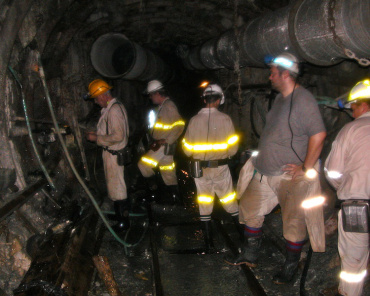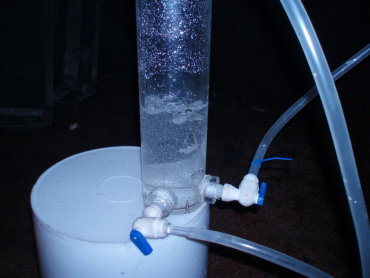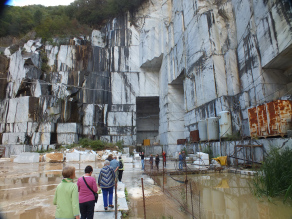This article was written by group member Dr Greg Holland, Senior Lecturer in Terrestrial Noble Gas Geochemistry
———— ———— ————
New group paper: Tracing ancient hydrogeological fracture network age and compartmentalisation using noble gases

Sample collection in Kidd Creek Mine, Canada. Note how wet the floor is! Photo credit: Barbara Sherwood
Very little is understood about the rocks thousands of metres beneath our feet but they are potentially very interesting from a geological perspective as they may hold a unique record of the evolution of Earth (and life) over geological time. Our lack of understand of this part of the crust is mainly because it is very inaccessible. Therefore a team of international scientists decided to use existing mines in Canada, already dug to several kilometres depth, as a pre-existing way to access the deep crust. Scientists from Manchester, Oxford and Canada collected gases and waters emanating from fissures in the mine shafts, three kilometres beneath the surface, and have found some of the oldest fluids in the planet’s history. The discovery is recently published in Geochimica Cosmochimica Acta (10.1016/j.gca.2017.10.022).

Gas and water samples being collected as they gush from fissures in mine shaft surfaces. Photo credit: Barbara Sherwood Lollar.
Using the noble gas mass spectrometry technique the team analysed all the noble gases in the samples (helium, neon, argon, krypton, and xenon). Because some noble gas isotopes are produced from radioactive decay, they we able to determine that the fluids they had collected had been isolated from modern water for up to 3 billion years – the oldest free fluids ever analysed at more than half the age of the Earth! These waters were so old that they possessed strange noble gas isotopes indicating how the crust 3 billion years ago was different to present day crust and also how the atmosphere has evolved over geological time. Ongoing work is also continuing into whether biological life in these fluids is different to life at the surface – i.e. is there a completely isolated biosphere beneath our feet that has remained separated from surface energy sources for billions of years? Clearly this has important implications for life on Mars, Europa, Enceladus and other places in the solar system where deep crustal fluids may exist, tucked away from the harsh environments of planetary body surfaces…..
———— ————
The full paper citation is: Warr, O., Lollar, B. S., Fellowes, J., Sutcliffe, C. N., McDermott, J. M., Holland, G., Mabry, J. C. & Ballentine, C. J. (2018) Tracing ancient hydrogeological fracture network age and compartmentalisation using noble gases Geochimica Et Cosmochimica Acta. 222, 340-362. DOI: 10.1016/j.gca.2017.10.022.
This paper can also be accessed via the University of Manchester library.
Advertisements Share this:





